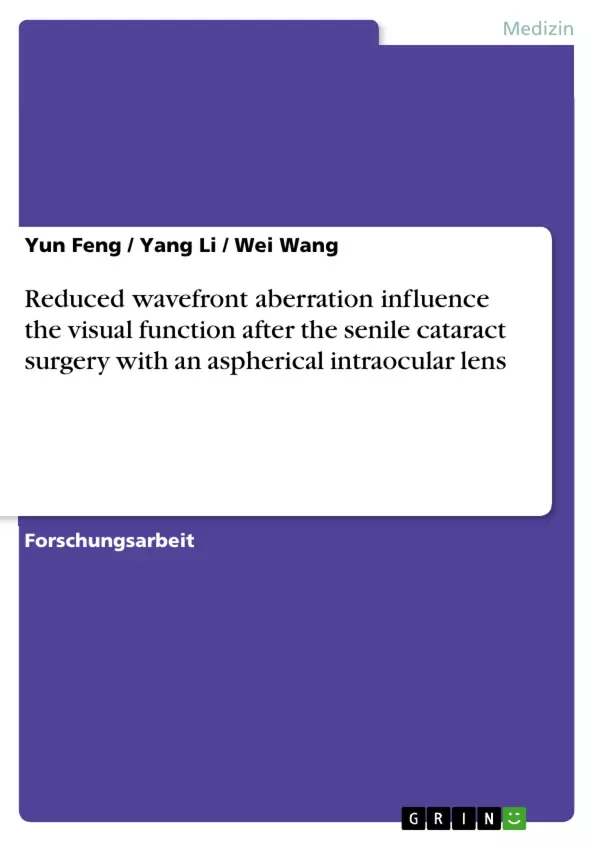Purpose: To evaluate whether the aspherical intraocular lens (IOL) with a modified aspherical anterior surface provides better quality of vision than the conventional spherical IOL for the senile cataract patients after phacoemusification and IOL implantation.
Inhaltsverzeichnis
- Objects &
- Objects of Study
- Research Material
- Intraocular lens
- Devices
- Methodology
- Checkups before-surgery include:
- Methodology of Surgery
- Postoperative checkups and follow-ups
- Participants chosen criterion:
- Methodology of Statistics
- Result
- Analysis on the correlation of age and pre-surgery testing results
- Pre-surgery VPS and comparison of subjective objective aberrations
- VPS comparison of each group 3-month before/after surgery
- Subjective/objective aberrations of each group collected on the first month, 3 months, or 6 months after surgery
- All parameters in group Tecnis indicate the existing of material differences in statistical tenns; shown as Table5
- Key parameters of objective and subjective aberrations comparlson before and after surgety, shov.n as Table 6.
- No statistical differences of objective/subjectlve aberrations before or after surgety in Group Sensar, shou•n as Table 7
- VPS scores comparison on different intraocular lens, collected on 3 months after surgery
- Best corrective visual acuities collected on each group on l-month, 3-month and 6-month before/after surgery
- Subjective/objective aberration comparison of different intraocular lens collected on l-month, 3-month and 6-month after surgery
- Subjective/Objective aberration collected on 1-month after surgery
- Comparison of subjective/objective aberrations at 3-month after surgeor
- Comparison of subjective objective aberration collected 6 months after surgery
- Contrast sensitivity comparisons on intraocular lens made one month, threemonths and six months before/after surgery, shown as Graph 7
- Sensitivity comparisons made 3 months after surgeor, shown as Graph 8:
- Discussion
- Conclusion
- Bibliography
Zielsetzung und Themenschwerpunkte
Diese Studie zielt darauf ab, die Auswirkungen von asphärischen Intraokularlinsen (IOLs) mit einer modifizierten asphärischen Vorderfläche auf die Sehqualität von Patienten mit altersbedingtem Grauem Star nach Phakoemulsifikation und IOL-Implantation zu untersuchen. Die Studie vergleicht die Sehqualität nach Implantation von asphärischen IOLs mit der Sehqualität nach Implantation von konventionellen sphärischen IOLs.
- Der Einfluss von asphärischen IOLs auf die sphärische Wellenfront-Aberration nach Katarakt-Operationen
- Die Auswirkungen von asphärischen IOLs auf die Sehfunktion, einschließlich der Sehschärfe, Kontrastempfindlichkeit und subjektiven Sehqualität
- Die Korrelation zwischen Alter und Wellenfront-Aberrationen
- Die Rolle der Wellenfront-Aberration bei der Sehqualität nach Katarakt-Operationen
- Die Bedeutung von Wellenfront-Aberrationen für die Entwicklung und Anwendung von IOLs
Zusammenfassung der Kapitel
Das erste Kapitel beschreibt die Zielsetzung der Studie, die Methodik und die Auswahl der Studienteilnehmer. Es werden die verwendeten IOLs und Geräte sowie die präoperativen und postoperativen Untersuchungen detailliert beschrieben. Das zweite Kapitel präsentiert die Ergebnisse der Studie, einschließlich der Korrelation zwischen Alter und Wellenfront-Aberrationen, der präoperativen und postoperativen Sehqualität, der Veränderungen der Wellenfront-Aberration nach der Operation und der Kontrastempfindlichkeit. Das dritte Kapitel diskutiert die Ergebnisse der Studie und setzt diese in den Kontext der aktuellen Forschung zu Wellenfront-Aberrationen und Katarakt-Operationen. Es wird auch die Bedeutung der Ergebnisse für die zukünftige Entwicklung von IOLs diskutiert.
Schlüsselwörter
Die Schlüsselwörter und Schwerpunktthemen des Textes umfassen Intraokularlinsen, Wellenfront-Aberrationen, Katarakt, Sehfunktion, asphärische IOLs, sphärische IOLs, Sehschärfe, Kontrastempfindlichkeit, Alter, Phakoemulsifikation, Sehqualität.
- Citar trabajo
- Yun Feng (Autor), Yang Li (Autor), Wei Wang (Autor), 2013, Reduced wavefront aberration influence the visual function after the senile cataract surgery with an aspherical intraocular lens, Múnich, GRIN Verlag, https://www.grin.com/document/213709



